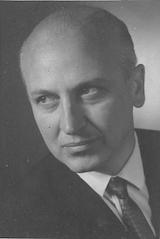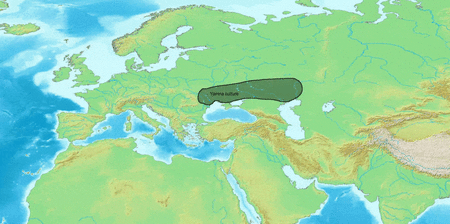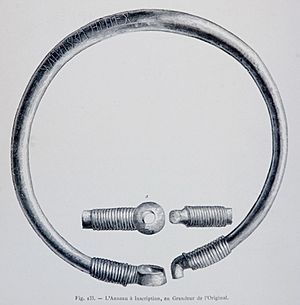Winfred P. Lehmann facts for kids
Quick facts for kids
Winfred P. Lehmann
|
|
|---|---|
 |
|
| Born | June 23, 1916 |
| Died | August 1, 2007 (aged 91) Austin, Texas, US
|
| Nationality | American |
| Alma mater | University of Wisconsin |
|
Notable work
|
|
| Spouse(s) |
Ruth Preston Miller
(m. 1940, died) |
| Children | 2 |
| Awards | Commander's Cross of the Order of Merit of the Federal Republic of Germany (1987) |
| Scientific career | |
| Institutions | |
| Doctoral advisor |
|
Winfred Philip Lehmann (June 23, 1916 – August 1, 2007) was an American expert in linguistics. He studied how languages change over time (historical linguistics), especially Germanic languages and Indo-European languages. He was a professor and led departments at the University of Texas at Austin for many years.
Lehmann also served as president of important groups like the Linguistic Society of America. He was a pioneer in machine translation, which is about teaching computers to translate languages. He taught many future scholars and wrote several important books about language.
Contents
Early Life and Education
Winfred P. Lehmann was born in Surprise, Nebraska on June 23, 1916. His father was a Lutheran minister, and his family spoke German at home. They moved to Wisconsin when he was a boy.
After high school, Lehmann studied German and classical philology (the study of ancient languages and texts) at Northwestern College. He earned his first degree in 1936. Then, he went to the University of Wisconsin.
At Wisconsin, Lehmann focused on phonetics (the study of speech sounds) and Indo-European and Germanic philology. He learned many languages, including Old Church Slavonic, Lithuanian, Old Irish, Sanskrit, and Old Persian. Later, he also learned Arabic, Hebrew, Japanese, and Turkish.
Two of his teachers, William Freeman Twaddell and Roe-Merrill S. Heffner, greatly influenced him. He worked closely with Heffner on phonetics. They wrote articles together about dialectology (the study of different language dialects) and sociophonetics (how social factors affect speech sounds). Lehmann earned his master's degree in 1938 and his PhD in 1941, both in Germanic linguistics. His PhD focused on verbs in Germanic languages.
Early Career and War Service
From 1942 to 1946, Lehmann served in the United States Army. During World War II, he taught Japanese to soldiers. This experience helped him learn about languages outside of Europe and taught him how to manage large projects. These skills were very useful later in his career.
After the war, in 1946, Lehmann started teaching German at Washington University in St. Louis. He wanted to focus more on linguistics, the scientific study of language.
Career at the University of Texas

In 1949, Lehmann moved to the University of Texas at Austin. He became an Associate Professor of Germanic Languages and then a full Professor. During this time, he published an important book called Proto-Indo-European Phonology (1952).
In 1953, Lehmann became the head of the Department of Germanic Languages. He also helped lead the Department of Slavic Languages. In 1963, he was named Ashbel Smith Professor of Linguistics and Germanic Linguistics, which was a very special title. In 1964, he became the first head of the new Department of Linguistics.
As a department head, Lehmann helped create excellent programs in German and linguistics. After the launch of Sputnik 1, there was a big need for language and linguistics experts. His programs received a lot of funding. Lehmann brought in many famous professors and organized important conferences.
Linguistics Research Center
In 1961, Lehmann started the Linguistics Research Center (LRC). He was its director until he passed away. Through the LRC, he got millions of dollars for machine translation and historical linguistics research. He also helped start centers for Middle Eastern and South Asian studies. He even worked with Gardner Lindzey on psycholinguistics, which studies how language and the mind work together.
Lehmann was known for his teaching style. He encouraged students to truly understand his lessons, not just memorize them. He gave detailed feedback on their work and pushed them to publish their research.
Under his leadership, the Germanic languages and linguistics departments at UT Austin became some of the best in North America. Almost 10% of all PhDs in linguistics in the U.S. during that time came from UT Austin. He guided over fifty PhD students and mentored hundreds more. Many of his students became leaders in their fields.
Leadership and Publications
Lehmann was president of the Linguistic Society of America in 1973. He was also president of the Modern Language Association of America in 1987. He is the only person to have led both of these very important organizations for linguistics in the United States.
He was also a member of many other groups, including the Association for Computational Linguistics. He received awards like the Fulbright and Guggenheim Fellowships.
Besides teaching and leading, Lehmann did a lot of research and writing. His book Historical Linguistics: An Introduction (1962) was translated into many languages and is still a key book today. He also edited Reader in Nineteenth Century Historical Indo-European Linguistics (1967). His book Proto-Indo-European Syntax (1974) was seen as a major breakthrough. In 1981, he published his influential work Syntactic Typology.
In 1983, Lehmann received the Harry H. Ransom Award for Teaching Excellence. He said this was the greatest honor of his career. In 1984, he helped develop a computer program for language translation with Jonathan Slocum.
Retirement and Later Works
Lehmann retired from teaching in 1986. However, he stayed very active as a researcher at the Linguistics Research Center. He continued to write books and articles. In 1986, he started a journal called Computers and Translation, which is now Machine Translation.
His book A Gothic Etymological Dictionary (1986) is considered one of the best books on Germanic word origins. In 1987, he received the Commander's Cross of the Order of Merit of the Federal Republic of Germany, a high honor from Germany.
In his later years, Lehmann wrote the third edition of Historical Linguistics (1992) and Theoretical Bases of Indo-European Linguistics (1993). He finished his last major book, Pre-Indo-European (2002), when he was 86 years old.
Death and Legacy
Lehmann passed away in Austin, Texas, on August 1, 2007. His wife, Ruth, and son, Terry, had passed away before him.
Throughout his life, Lehmann wrote over fifty books and more than 250 articles. His writings covered many topics, from Middle High German literature to Japanese grammar. His work in Indo-European, Germanic, and historical linguistics, and machine translation, was very important. Many of his books are still used as standard texts today. He is remembered for helping make the University of Texas at Austin a top place for linguistics. He also taught and guided many students who went on to make big contributions to language studies.
Personal Life

Winfred Lehmann married Ruth Preston Miller on October 12, 1940. They met while studying at the University of Wisconsin. Ruth was also a professor at the University of Texas at Austin. She specialized in Celtic linguistics and Old English. Winfred and Ruth had two children, Terry Jon and Sandra Jean.
Both Winfred and Ruth loved the environment and animals. They donated land in Travis County, Texas to The Nature Conservancy. This land became the Ruth Lehmann Memorial Tract. The family lived in a large house on Lake Travis, where they cared for rescued animals.
Besides linguistics and the environment, Lehmann loved literature. He especially enjoyed early Germanic literature and the novels of his friends. He was also a talented pianist. He was good friends with physicist John Archibald Wheeler, and they shared an interest in literature. Even though he had many friends, Lehmann was a very private person.
Selected Works
- (With Alfred Senn) A Word Index to Wolfram's "Parzival,", University of Wisconsin-Madison, 1938
- (With Roe-Merrill S. Heffner) A Word-Index to the Poems of Walther von der Vogelweide, University of Wisconsin-Madison, 1940
- (With Lloyd Faust) A Grammar of Formal Written Japanese, Harvard University Press, 1951
- Proto-Indo-European Phonology, University of Texas Press and Linguistic Society of America, (1952)
- The Alliteration of Old Saxon Poetry, Aschehoug, (1953)
- (With J. L. Dillard) The Alliterations of the Edda, University of Texas, 1954
- The Development of Germanic Verse Form, University of Texas Press and Linguistic Society of America, 1956
- (With Helmut Rheder and George Schulz-Behrend) Active German, Dryden, 1958, 2nd edition, including revised Handbook, records, and tapes, published as Active German Revised, Holt, 1962.
- (With Takemitsu Tabusa) The Alliterations of the Beowulf, Department of Germanic Languages, University of Texas, 1958
- (With Helmut Rehder, L. Shaw, and S. N. Werbow) Review and Progress in German, Holt, 1959
- (With Virginia F. Dailey) The Alliterations of the Christ, Guthlac, Elene, Juliana, Fates of the Apostles, and Dream of the Rood, Department of Germanic Languages, University of Texas, 1960.
- Historical Linguistics: An Introduction, Holt, 1962, 2nd edition 1973, 3rd edition, 1992
- Exercises to Accompany Historical Linguistics: An Introduction, Holt, 1962, 2nd edition, 1973.
- (With Helmut Rehder and Hans Beyer) Spectrum: Modern German Thought in Science, Literature, Philosophy and Art, Holt, 1964.
- (With H-J. Hewitt) Selected Vowel Measurements of American English Speech, University of Texas, 1965.
- Computational Linguistics: Procedures and Problems, Linguistics Research Center, University of Texas, 1965.
- (Editor and translator) A Reader in Nineteenth Century Historical Indo-European Linguistics, Indiana University Press, 1967.
- (Editor with Yakov Malkiel) Directions for Historical Linguistics: A Symposium, University of Texas Press, 1968.
- Descriptive Linguistics: An Introduction (includes Instructor's Manual), Random House, 1972, 2nd edition, 1976.
- (With T. J. O'Hare and Christoph Cobet) German: Language and Culture (includes student workbook and teacher's manual), Holt, 1972.
- Proto-Indo-European Syntax, University of Texas Press, 1974.
- (Editor) Language and Linguistics in the People's Republic of China, University of Texas Press, 1975.
- (R. P. M. Lehmann) An Introduction to Old Irish, Modern Language Association of America, 1975.
- (Editor) Syntactic Typology: Studies in the Phenomenology of Language, University of Texas Press, 1978
- Linguistische Theorien der Moderne, Peter Lang, 1981
- (Editor) Syntactic Typology, University of Texas Press, 1981
- Language: An Introduction, Random House, 1982
- (Editor with Yakov Malkiel) Perspectives on Historical Linguistics, Benjamins, 1982
- (Editor) Natural Language Processing, 1985
- (Editor) Language Typology 1985: Papers from the Linguistic Typology Symposium, Moscow, December 9–13, 1985, John Benjamins, 1985
- A Gothic Etymological Dictionary, Brill, 1986
- (Editor) Computers and Translation, 1986–1987
- (Editor) Language Typology, 1987: Systematic Balance in Language, Benjamins, 1990
- (Editor with Helen-Jo Jakusz Hewitt) Language Typology 1988: Typological Models in Reconstruction, Benjamins, 1991
- Die gegenwärtige Richtung der indogermanistischen Forschung, Archaeological Institute of the Academy of Sciences, 1992
- Theoretical Bases of Indo-European Linguistics, Routledge, 1993
- Residues of Pre-Indo-European Active Structure and their Implications for the Relationships among the Dialects, Institut für Sprachwissenschaft der Universität Innsbruck, 1995
- Theoretical Bases of Indo-European Linguistics, Routledge, 1996
- (With Esther Raizen and Helen-Jo Jakusz Hewitt) Biblical Hebrew: An Analytical Introduction, Wings Press, 1999
- Pre-Indo-European, Institute for the Study of Man, 2002


